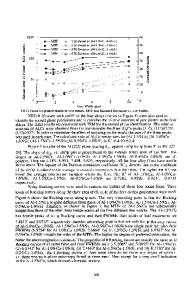Statistical Analysis of Electromigration Lifetimes and Void Evolution for Cu Interconnects
- PDF / 532,907 Bytes
- 6 Pages / 612 x 792 pts (letter) Page_size
- 38 Downloads / 321 Views
F7.7.1
Statistical Analysis of Electromigration Lifetimes and Void Evolution for Cu Interconnects M. Hauschildt*, M. Gall, S. Thrasher, P. Justison, L. Michaelson, R. Hernandez, H. Kawasaki, and P. S. Ho*. *The University of Texas at Austin, PRC/MER, Mail Code R8650, Austin, TX 78712 Freescale Semiconductor, MD K10, 3501 Ed Bluestein Blvd, Austin, TX 78721 ABSTRACT Electromigration (EM) failure statistics and the origin of the lognormal deviation (σ) for Cu interconnects have been investigated by analyzing the lifetime statistics and void size distributions at various stages during EM testing. Experiments were performed on 0.18 µm wide Cu interconnects with tests terminated after specific amounts of resistance increases, or after a specified test time. Void size distributions of resistance-based, as well as time-based EM tests were obtained using focused ion beam (FIB) microscopy. The lifetime and void size distributions were found to follow lognormal distribution functions. The σ values of EM lifetime and time-based void size distributions decrease with higher percentages of resistance increase, reaching an asymptotic value of σ ~ 0.14. In contrast, σ values of resistance-based void size distributions are significantly smaller and do not show an obvious dependence on time. The statistics of resistance-based void size distributions can mainly be accounted for by geometrical variations of the void shape, while the statistics of time-based void size distributions requires consideration of kinetic aspects of the EM process. The σ values of EM lifetime distributions at long times can be simulated based on measured void size distributions, taking into account geometrical and experimental factors of EM. In contrast, for short times the statistics of initial void formation and the kinetics of interfacial mass transport have to be considered. INTRODUCTION The introduction of Cu and low-k dielectrics and continuing scaling of on-chip interconnects raise serious reliability concerns on electromigration (EM) and stress-induced voiding (SIV). EM failures in Cu interconnects occur mainly by void growth at the cathode end of the line. With continuing void growth, the line resistance increases, eventually leading to failure of the line. The corresponding failure times usually follow a lognormal distribution with the median lifetime depending on the quality of the interface, which controls the mass transport [1-4]. Since EM experiments are conducted at higher current densities and temperatures compared to operating conditions, extrapolations are needed to assess reliability at operating conditions. The extrapolated lifetime depends linearly on the measured median lifetime and exponentially on the activation energy and the lognormal standard deviation σ. Several recent studies have shown that the median lifetime of Cu interconnects can be significantly improved by strengthening the top interface. Such efforts include the inclusion of a thin layer of CoWB between Cu and the passivation layer [5-7], as well as alloying Cu with small
Data Loading...











